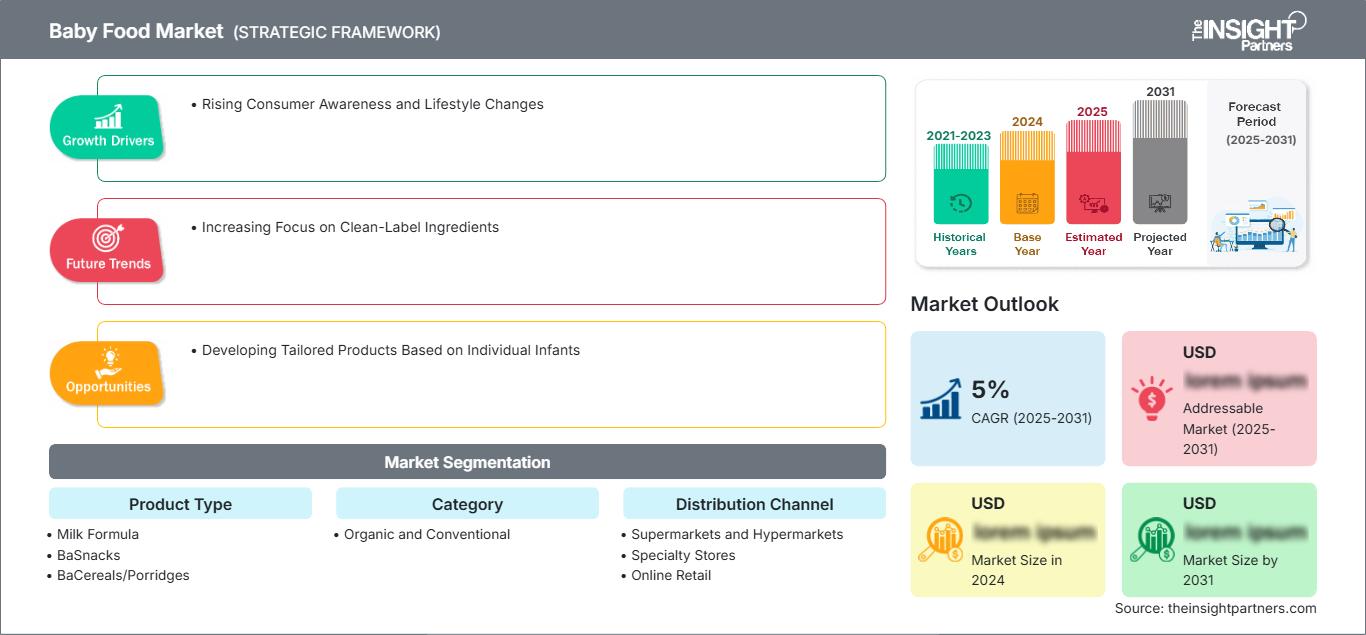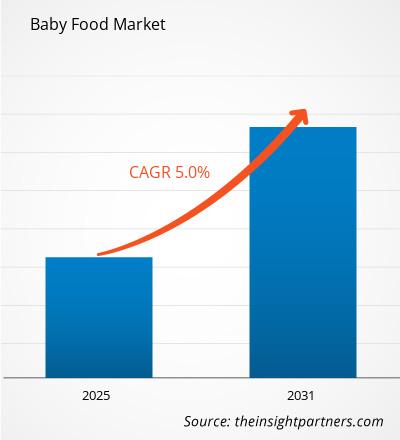The baby food market is expected to register a CAGR of 5% during 2023–2031. Increasing focus on clean-label ingredients is likely to remain a key trend in the market.
Baby Food Market Analysis
- The baby food market will experience further growth and innovation in the next few years through these proposed avenues.
- Ongoing urbanization, growing levels of disposable income, and rising awareness of infant nutrition thanks to social media and greater access to medical information are all likely to fuel rising demand, especially in developing markets. Furthermore, more parents are being swayed by a quest for natural and organic ingredients – and by what is termed 'clean labeling,' which focuses on listing natural ingredients on the packaging.
- Plant-based alternatives are becoming more mainstream, especially as consumers seek out different foods for dietary and environmental reasons. Food made with advanced food science and technology could also be more widely available in individualized products that depend on analyses of infants' specific nutritional needs.
- Distribution is likely to come from more e-commerce and direct-to-consumer channels, bringing more convenience – and causing more disruption to retail players.
Baby Food Market Overview
- The market for baby food is well-established, but it remains fragmented due to the fact that parents' shopping habits and understanding of what their infants require are constantly changing.
- Urbanization, women's expanding participation in the workforce, and rising per-capita disposable incomes all soar in emerging economies. These are the markets poised to see demand.
- Parents continue to demand more natural, healthy, and organic foods, fuelling a clean-label and plant-based revolution.
Customize This Report To Suit Your Requirement
You will get customization on any report - free of charge - including parts of this report, or country-level analysis, Excel Data pack, as well as avail great offers and discounts for start-ups & universities
Baby Food Market: Strategic Insights

-
Get Top Key Market Trends of this report.This FREE sample will include data analysis, ranging from market trends to estimates and forecasts.
Baby Food Market Drivers and Opportunities
Rising Consumer Awareness and Lifestyle Changes Drives Baby Foods Market
- Increasing consumer awareness and lifestyle changes are the key factors driving the baby food market.
- As parents become more informed about nutrition and child development, their purchasing decisions are moving in line with their newfound sensibilities and knowledge about infant health. This new awareness has spilled over into consumer demands for clearer labelling, cleaner products and ingredients, and fortified nutrients to promote optimal growth and development.
- Social media and parent-to-parent platforms have increased the speed at which information is shared, so parents can pass along personal experiences and product recommendations – even influencing where they purchase from and what brand loyalties they hold. The rise of this online, connected community has put pressure on companies to stay above board, and to quickly respond in a transparent way to consumer concerns.
- Meanwhile, lifestyle changes –primarily the modern trend of life in the urban area – have prompted the demand for readily available baby food for busy working parents. It became easier to feed their babies with baby food rather than properly prepare their own food.
Developing Tailored Products Based on Individual Infants
- Consumer genetic analysis reveals the internal nutritional profile of each infant, combined with data about his age, weight and stage of development, not to mention parental feedback about the specific health goals they are striving for. Companies can create formulations that precisely match the nutritional requirements of each child based on this information. Tailored nutritional needs through formula clearly give parents what they want: finely calibrated nutrition optimized for their children's needs. At the same time, it addresses the larger eagerness for personalization in health.
- As more parents discover how crucial early nutrition is for long-term health outcomes, they'll request more of these individually targeted options, no doubt seeing them as an investment in their child's future. In this way, the health of babies could be enhanced, the risk of allergy or intolerance lowered, and developmental support optimized. For the manufacturers of baby food, this is an opportunity to carve out a niche in a competitive market and, hopefully, reap the rewards of premium-priced products.
Baby Food Market Report Segmentation Analysis
Key segments that contributed to the derivation of the baby food market analysis are product type, category, and distribution channel.
- Based on product type, the market is segmented into milk formula (stage 1 milk formula, follow-up milk formula, toddler milk formula, and specialty formula), baby snacks (sticks, puffs, snack bars, dried fruits, and others), baby cereals/porridges, and others.
- On the basis of category, the market is divided into organic and conventional.
- On the basis of distribution channel, the market is segmented into supermarkets and hypermarkets, specialty stores, online retail, and others.
Baby Food Market Share Analysis by Geography
- Baby Food Market Report comprises a detailed analysis of five major geographic regions, which includes current and historical market size and forecasts for 2021 to 2031, covering North America, Europe, Asia-Pacific (APAC), Middle East and Africa (MEA), and South & Central America.
- Each region is further sub-segmented into respective countries. This report provides analysis and forecasts of 18+ countries, covering baby food market dynamics such as drivers, trends, and opportunities that are impacting the markets at the regional level.
- Also, the report covers Porter's analysis, which involves the study of major factors that influence the baby food market in these regions.
The regional trends and factors influencing the Baby Food Market throughout the forecast period have been thoroughly explained by the analysts at The Insight Partners. This section also discusses Baby Food Market segments and geography across North America, Europe, Asia Pacific, Middle East and Africa, and South and Central America.
Baby Food Market Report Scope
| Report Attribute | Details |
|---|---|
| Market size in 2024 | US$ XX million |
| Market Size by 2031 | US$ XX Million |
| Global CAGR (2025 - 2031) | 5% |
| Historical Data | 2021-2023 |
| Forecast period | 2025-2031 |
| Segments Covered |
By Product Type
|
| Regions and Countries Covered |
North America
|
| Market leaders and key company profiles |
|
Baby Food Market Players Density: Understanding Its Impact on Business Dynamics
The Baby Food Market is growing rapidly, driven by increasing end-user demand due to factors such as evolving consumer preferences, technological advancements, and greater awareness of the product's benefits. As demand rises, businesses are expanding their offerings, innovating to meet consumer needs, and capitalizing on emerging trends, which further fuels market growth.

- Get the Baby Food Market top key players overview
Baby Food Market News and Recent Development
The baby food market is evaluated by gathering the qualitative and quantitative data post primary and secondary research, which include important corporate publication, association data, and database. The few developments in the baby food market are listed below:
- Little Spoon, the leading direct-to-consumer baby and kids nutrition brand and go-to destination for the modern parent, announces its expansion into the baby snack category with the release of their rice-free graspable organic Puffs. Offering an innovative and nutritious solution for infant snacks, Little Spoon Puffs encourage self-feeding and fine motor skill development for babies over 6 months. A new segment within Little Spoon's baby category, this launch further solidifies the brand's mission to make modern parents' lives easier with feeding solutions from baby's first bites through big kid years. (Source: BevNET.com, Inc, Press Release, March, 2024)
- Happy Family Organics, an organic baby food brand in the U.S., announced a new pouch line — Happy Baby Savory Blends. Crafted for little ones 6+ months, Happy Baby Savory Blends contains 1 ½ servings of organic vegetables per pouch, reportedly more vegetables in one pouch than any other leading baby food brand. The recipes feature organic vegetables blended with flavorful fats, herbs and spices. According to Happy Family Organic, it is the largest baby food brand to announce it is joining Partnership for a Healthier America's (PHA) Veggies Early & Often campaign, making a series of commitments that include doubling its vegetable-forward products over the next three years. (Source: BNP Media, Press Release, April, 2021)
Baby Food Market Report Coverage and Deliverables
The " Baby Food Market Size and Forecast (2021–2031)" report provides a detailed analysis of the market covering below areas:
- Baby Food market size and forecast at global, regional, and country levels for all the key market segments covered under the scope
- Baby Food market trends as well as market dynamics such as drivers, restraints, and key opportunities
- Detailed PEST/Porter's Five Forces and SWOT analysis
- Baby Food market analysis covering key market trends, global and regional framework, major players, regulations, and recent market developments
- Industry landscape and competition analysis covering market concentration, heat map analysis, prominent players, and recent developments for the baby food market
- Detailed company profiles
Frequently Asked Questions
What are the driving factors impacting the global baby food market?
What are the future trends of the baby food market?
What is the expected CAGR of the baby food market?
Which are the leading players operating in the baby food market?
What are the deliverable formats of the baby food market report?
What are the options available for the customization of this report?
- Historical Analysis (2 Years), Base Year, Forecast (7 Years) with CAGR
- PEST and SWOT Analysis
- Market Size Value / Volume - Global, Regional, Country
- Industry and Competitive Landscape
- Excel Dataset
Recent Reports
Related Reports
Testimonials
Reason to Buy
- Informed Decision-Making
- Understanding Market Dynamics
- Competitive Analysis
- Identifying Emerging Markets
- Customer Insights
- Market Forecasts
- Risk Mitigation
- Boosting Operational Efficiency
- Strategic Planning
- Investment Justification
- Tracking Industry Innovations
- Aligning with Regulatory Trends





















 Get Free Sample For
Get Free Sample For